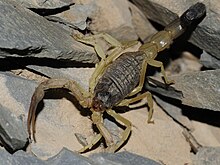Hottentotta
| Hottentotta | |
|---|---|
 |
|
| Hottentotta jayakari jayakari | |
| Scientific classification | |
| Kingdom: | Animalia |
| Phylum: | Arthropoda |
| Subphylum: | Chelicerata |
| Class: | Arachnida |
| Order: | Scorpiones |
| Family: | Buthidae |
| Genus: |
Hottentotta Birula, 1908 |
| Type species | |
|
Scorpio hottentotta Fabricius, 1787 |
|
| Diversity | |
| About 39 species | |
| Synonyms | |
|
|
Hottentotta is a genus of scorpion belonging to the family Buthidae. It is distributed widely across Africa. Species also occur in the Middle East, the Arabian Peninsula, southeastern Turkey, Iraq, Iran, Afghanistan, Pakistan, India, Nepal, Cape Verde Islands, Slovenia (rarely) and Sri Lanka (introduced).
The genus was introduced in 1908 by A. A. Birula, originally as a subgenus of the genus Buthus. It was elevated to genus rank by F. Werner in 1934.Buthotus Vachon, 1949 is an often used but outdated synonym of Hottentotta.
Some authors subdivided the genus into three subgenera, Hottentotta (Hottentotta), Hottentotta (Balfourianus) Vachon, 1979, and Hottentotta (Deccanobuthus) Lourenço, 2000. The latest taxonomic reviews of this genus by F. Kovařík reject this subdivision and recognizes a single, undivided genus Hottentotta. The differences separating the closely related genus Mesobuthus from Hottentotta are very subtle and species have been often been misassigned among the two genera.
The content of this genus may vary, depending on the authority. At least 40-41 species are known:
Members of Hottentotta are generally moderately sized scorpions, with a total length of 70–90 millimetres (2.8–3.5 in); the smallest species are 30 millimetres (1.2 in) long, while the largest species reach 100–130 millimetres (3.9–5.1 in). They belong to the most colorful species of scorpions. The base color ranges from bright yellow to black, with most species colored in brown or reddish tones. Many species are ornamented by color spots or bands especially on the mesosoma. Coloration may be considerable variable between individuals of the same species or among regional populations.
...
Wikipedia
